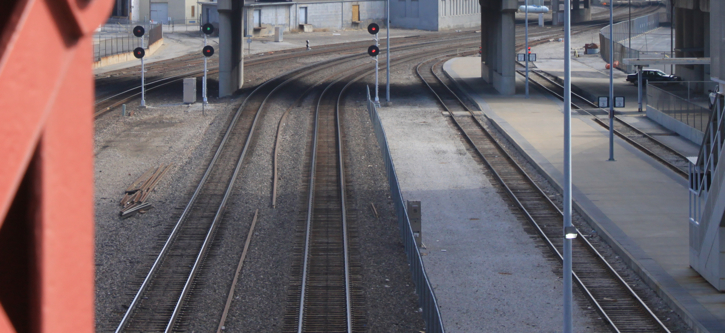Trains Can Only Go One Direction at a Time
A train can only be moving either forward or backward. It can't be doing both at the same time. And if a train is your journey to financial freedom, then your spending/saving is the direction it's moving. (I thought a train analogy would be fun...here we go!) Four years ago, we were pulling the brakes on our train. Trying to slow it down. We didn't know any better before that, but as we were rolling down the tracks we figured out that while we were going fast, we were going in the wrong direction. We had been educated on a better way to take care of our finances (through Financial Peace University), and we knew we had to change directions.

Knowing is one thing, but how in the world do you slow down a locomotive, bring it to a stop and get it to reverse directions?
Trains can't stop quickly or swerve. The average freight train is about 1 to 1¼ miles in length (90 to 120 rail cars). When it's moving at 55 miles an hour, it can take a mile or more to stop after the locomotive engineer fully applies the emergency brake. (from here)
How to get the train to reverse directions
Trains and money can do lots of things. They are tools that serve great purposes. But as the engineer, it's our job to make the tools work to help us accomplish our goals. A freight train is useless and can cause great trouble if it ends up at the wrong destination.
Same can be true of our finances. We all have a picture in our minds of where we want to end up, but how do we know we're going to arrive at the right destination?
Knowing we needed to change directions, let's look at the steps we had to take to make that happen. Because, like trains, our spending habits are big and heavy, and it can be hard to change directions. It takes focus, dedication, action, time and discipline.
Focus
Once we knew we were headed in the wrong direction, we were motivated and wanted to instantly move start going the right direction. But, we had to keep our head down and focus first on slowing down. Because simply flipping things in reverse is not an option. It was easy to get distracted or give up. We would have a massive train car pile-up and that would be no good. Slowing down our spending bit by bit, month by month, and budgeting were how we applied the brakes.
Dedication
For awhile it was really tough to see progress, we were still in debt, and in terms of this analogy, we were still moving in the wrong direction. Although we were slowing down, it was still painful not moving in the right direction. But, now we were applying forces of both focus and dedication to our goal of changing directions.
Action
Sometimes you have to throw things overboard, or call all hands on deck. We took on extra work, spent our savings down to $1,000 (putting it toward debt), and temporarily stopped contributing to our 401(k)s to speed up the process of getting out of debt. Continuing to watch all of our gauges (focus, dedication and applying action) to make sure we're still making progress in slowing down the train.
Time
We were doing the right things, and we could tell we would be coming to a stop soon, all we had to do was continue to work our plan and make sure the previous processes and procedures were being followed. Patience was a lesson learned during this time.
Discipline
As time passed, we became diligent and disciplined in what we were doing. Not perfect, but we were getting stronger. And bit by bit, we applied the forces above and made the train stop. It came to rest, and we were no longer moving in the wrong direction, but standing neutral on the tracks. It felt really good to have stopped. No more train noises, clanking, chugging, choo-chooing going on. Peaceful. Debt-free.
We paused briefly for a breathe of fresh air and then started applying what we had learned to get the train moving again. This time in the right direction.
Once we were putting money back into our emergency fund, it was an amazing feeling. We were still moving slow, but in the right direction at least. And as time has gone on (two-plus years now), the train has been increasing speed. (And remember, it's a train. It doesn't have the best 0-60 acceleration.) Little by little, we've had to continue to work at increasing the train's speed by staying focused, dedicated, taking action, being patient and being disciplined.
And are we ever at top speed or max efficiency? Probably not. There's always ways to improve. And we're trying to enjoy the journey as well.
To summarize... The road to financial freedom is a long one. It takes a lot of effort, but it also takes a lot of time and patience. (I have to remind myself of that by writing this post.) It's also important to note how hard and painful it would be to change directions many times. Trains are not known for agility.
So take courage, have hope and keep honing the skills needed get your train moving in the right direction.
How are you working to change the directions in your personal finance?
